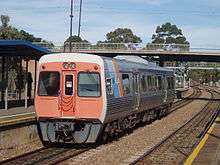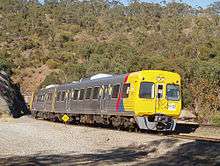3000 class railcar
| 3000/3100 class railcars | |
|---|---|
|
3121/3122 crossing the Port River at Ethelton in April 2005 | |
|
Interior of a refurbished unit | |
| Manufacturer |
Comeng Clyde Engineering |
| Built at | Dandenong |
| Replaced | 300/400 class Red Hens |
| Constructed | 1987-96 |
| Entered service | 1987 |
| Number built | 70 |
| Fleet numbers |
3001-3030 3101-3140 |
| Capacity |
106 passengers (3000) 113 passengers (3100) |
| Operator(s) |
State Transport Authority TransAdelaide |
| Depot(s) |
Dry Creek Gawler Lonsdale Belair |
| Specifications | |
| Maximum speed | 90 km/h (Network Speed) |
| Weight |
48t (3000) 46t (3100) |
| Transmission | Diesel-electric |
| Track gauge | 1,600 mm (5 ft 3 in) |
The 3000/3100 class are a class of diesel railcars operated by Adelaide Metro (and its predecessors STA and TransAdelaide). They were built by Comeng and Clyde Engineering, all in Dandenong, between 1987 and 1996.
History

In March 1985, the State Transport Authority awarded a tender for 20 diesel multiple units (eight 3000 class units with a cab at each end and twelve 3100 class with a cab at one end only) to Comeng, Dandenong.[1] The design was based on the stainless steel shell of the Comeng electric train then in production for Melbourne's Public Transport Corporation, but 2.3 metres longer and with only two doors per side. Because of a contractual requirement to maxmise local content, the fitout was conducted at Dry Creek.[2] The first entered service in November 1987. A further 50 were ordered and built between 1992 and 1996 by Clyde Engineering, still at Comeng's former Dandenong factory.[3][4]
Mechanics

Each railcar features an underfloor mounted Mercedes Benz 475 hp V12 twin turbo direct injection diesel engine, operating at a constant 1500 RPM, which is directly coupled to a Reliance 400kVA alternator. Drive is provided by two Stromberg traction motors, rated at a continuous 130 kW each, mounted on a single bogie. The railcars also feature an auxiliary transformer providing 3 phase 50 Hz at 415 V which supplies air-conditioning and other ancillary power needs.[5]
The 3000 class bogies are built by Comeng and feature airbag secondary suspension. All 3000 class railcars are fitted with electro-magnetic track brakes, which are comparatively rare on trains, though they are commonly found on trams. These are operated separately from the normal mechanical and dynamic braking.
Trains are equipped with automatic Scharfenberg couplers which are operated from the driver's cab. Coupling operations are sometimes performed at Adelaide station, requiring an extra staff member to flag the driver as well as to connect the safety chains. This feature allows sets of up to six cars to be formed.
Two headlights are mounted at the top of the car in the centre on driver's cab ends. There are no marker lights at the front; however, there are red marker lights for the rear located on the upper corners.
There are metal steps up the side of the car to each door, but they are not used by passengers. They are illuminated by lights at night.
All cars are air-conditioned.
Refurbishment & electrification
In the 2008/09 State Budget it was announced that five out of six of Adelaide's railway lines were to be electrified commencing with the Noarlunga and Gawler lines. This was to have resulted in 58 of the 3000/3100 class railcars being converted to electric operation with the remaining 12 to be retained as DMUs for operation on the Belair railway line[6][7] However with the Gawler line electrification now in doubt after Federal Government funding was withdrawn, this may change.[8]
It is anticipated that all converted 3000 class railcars will be semi-permanently coupled into two car sets sharing a single pantograph, and reclassified as the 3200 class. The 3100's existing semi-permanently coupling will remain unchanged other than being converted to electric traction.
Specifications
| 3000 class | |
|---|---|
| Track Gauge: | 1,600 mm (5 ft 3 in) |
| Transmission: | Diesel-electric |
| Power Plant: | One Twin turbo-charged Mercedes Benz V12 354 kW (475 hp) direct injection underfloor diesel engine + 400kVA alternator powering one bogie |
| Maximum service speed: | 90 km/h (network max. speed, able to travel faster if track permits) |
| Number in class: | 30 |
| Unit numbers: | 3001-3030 |
| Introduced: | 1987-96 |
| Built by: | 3001-3008 Comeng 3009-3030 Clyde Engineering |
| Passenger Seating capacity: | 106 |
| Weight: | 48 tonnes |
| 3100 class | |
|---|---|
| Track Gauge: | 1,600 mm (5 ft 3 in) |
| Transmission: | Diesel-Electric |
| Power Plant: | One Twin turbo-charged Mercedes Benz V12 354 kW (475 hp) direct injection underfloor diesel engine + 400 kVA alternator powering one bogie at the drivers cab end |
| Maximum service speed: | 90 km/h (network max. speed, able to travel faster if track permits) |
| Number in class: | 40 |
| Unit numbers: | 3101-3140 |
| Introduced: | 1988-96 |
| Built by: | 3101-3112 Comeng 3113-3140 Clyde Engineering |
| Passenger Seating capacity: | 113 |
| Weight: | 46 tonnes |
References
- ↑ "South Australia" Railway Digest July 1985 page 215
- ↑ Dunn, John (2012). Comeng: A History of Commonwealth Engineering Volume 5: 1985-2012. Kenthurst: Rosenberg Publishing. pp. 77–83. ISBN 9781922013521.
- ↑ 3000 Class Rail SA
- ↑ 3100 Class Rail SA
- ↑ Baker, Brett (April 2009). "Rail revitalisation: a decade of change for TransAdelaide". Institution of Railway Signal Engineers Australasia: AGM & technical meeting: Adelaide.
- ↑ Antimo Iannellaa (24 September 2008). "More standing room on trains". AdelaideNow. Archived from the original on 27 September 2008. Retrieved 2008-09-25.
- ↑ Budget 2008/09 Government of South Australia
- ↑ SA electrification up in air after feds pulls out Rail Express 30 October 2013
Further reading
- Further information on the 3000 and 3100 series railcar, including several interior photographs
- Australian Railway Historical Society Bulletin June 1988 pp121–128

.jpg)